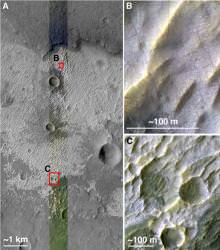Researchers announced today that they have discovered large salt deposits on the surface of Mars. These deposits point to places where large quantities of water existed on the surface of the Red Planet, perhaps for millions of years. And this might be some of the best places to go looking for evidence of life, past and present.
A team led by Mikki Osterloo at the University of Hawaii, Honolulu have turned up approximately 200 separate spots on southern Mars that seem to have ancient deposits of sodium chloride. In other words, they’ve found table salt sitting on the surface of Mars.
The sites, discovered by NASA’s Mars Odyssey spacecraft, range in size from 1 square km (.6 square miles) to 25 square kms.
So how did this salt get there? One possibility is that it came from groundwater, reaching the surface in low spots. The water would evaporate and leave the mineral deposits over the course of millions of years. Since the sites are largely disconnected from one another, it rules out the possibility the salt was left by an ocean that evaporated billions of years ago.
“Many of the deposits lie in basins with channels leading into them,” said Philip Christensen, co-author and principal investigator for the camera at Arizona State University. “This is the kind of feature, like salt-pan deposits on Earth, that’s consistent with water flowing in over a long time.”
Don’t go looking for life today, though. The scientists think the salt deposits were formed approximately 3.5 to 3.9 billion years ago. This was a time when Mars had much warmer and wetter conditions than the frigid, dry climate on the planet today.
Until now, researchers have been looking for other evidence of past water on the surface of Mars, like clay or sulfate minerals. Clay is evidence that a region was weathered by water, and sulfates are caused by water evaporation. These salts offer an alternative place to look for evidence of past life.
To get salt deposits of this size, you would need to have large quantities of water sitting on the surface of Mars for a long time. And this is crucial in the search for life. You want a habitat that endures for a long time.
Original Source: NASA/JPL News Release


In the end what benefits can we hope to obtain by knowing that there was life on mars 3 billion years ago.
The benefit of this knowledge of non-Earth life would be, at the simplest level, the thrill of knowing that if life existed on Mars, might it not exist on Titan in a primal way, or even around other stars in various stages of advancement. This, in itself, is enough to send a frisson of giddy excitement up one’s spine.
It is profoundly important to the nature and abundance of life in this galaxy. We currently only have a sample of one–life on Earth–and nothing to compare it with. The discovery of life on Mars, even long extinct life on Mars could hold extremely important concerning the origins of life here on Earth. (There’s a chance we might even be related).
Sure, it’s not going to benefit us in our day-to-day lives in any material way, but then neither does about 99% of the entertainment industry, and we spend far more money on that!
But long term, who knows what ramifications such a discovery could have? It could well get us to Mars quicker to investigate.
LLDiaz wrote “In the end what benefits can we hope to obtain by knowing that there was life on mars 3 billion years ago.”
It helps us understand our place in the universe – is life unique? is life merely unusual? is life common? I would find it a thrill of the highest magnitude.
Likewise.If past life is found so easily on mars or a nearby moon,Id believe that life as a whole in the universe would be abundant.And knowing this,perhapse our worlds people would be more willing to get over the huddle of segrigation and war.
Sadly, probably not.
Really? If I had an envelope, containing the answer to the question – was there life on Mars 3 billion years ago? – wouldn’t you want to open it? Wouldn’t you want to just take a little peek and know the answer for sure?
Science is often about pure curiosity. Is Earth the only place in the Universe with life? That’s a pretty important question.
What scares me is people who can actually see a fantastic Hubble photo of a nebula with no reaction.
I’m no geologist, but wouldn’t salt deposits on the surface be either covered by dust or sandblasted away in 3 billion years? And if the deposit are thick, then wouldn’t that say there was a lot of water holding a lot of salt to creat a thick layer? Just wondering.
🙂
I enjoy all discoverys and the news and I just can say everything it’s amazing
Some scientists believe that approximately 3.5 billion years ago, conditions on Mars and Earth were somewhat similar. Earth was undergoing tectonic changes on a course to establishing the biosphere that we all enjoy today. At about the same time, conditions on Mars were deteriorating; the atmosphere was thinning, water would soon (in a geological sense) be gone. So it is not entirely surprising to find parallels between these two worlds. The real question is this: can we save Earth’s biosphere before Mars and Earth resemble each other again?
Re Susan
If you beleive what’s going on with pollution & Global Warming, the answer would be ,’sadly, no’.